—by M1911A1—
We all have our own ideas about what makes one holster more appropriate for self-defensive concealed carry than another. And consider all of the choices that you have to make: Inside the pants or outside the pants, high-ride or mid-ride, FBI cant or straight up, Kydex or leather. The variations are endless, and we could go on and on.
But in reality, there is only one thing about holsters that is absolutely necessary: quick, sure access. The holster must help you get your pistol into play as quickly as possible by letting you instantly establish a complete, firm, full firing grip on the gun before you ever begin your draw stroke.
Why? Because when you are faced with a life-threatening attack, you don’t have time to make adjustments to the way that you’re holding your gun. You need to “come out swinging,” without halt or hesitation, right then and there. And remember that, when you’re in a save-your-life panic and adrenaline is coursing through your veins, your so-called small motor skills will disappear. Adjustments will become fumbles, and fumbles will become gun-dropping disasters.
Any holster style could give you quick, sure access to your pistol, but not all of them do. One maker’s work may even include both good, quick-access, and bad, fumble-prone, designs. Some holsters, particularly the “hybrid” inside-the-pants (IWB) kind, allow you to adjust their positions almost infinitely, and you can make your grab very sure, quick, and easy, or you can arrange the rig to almost guarantee a bobble.
Let’s look at a few sample holsters, with some comments about their suitability. The point here is not to recommend one manufacturer or another, or even any specific rig, but rather only to illustrate good design points and also bad ones, and to help you make better purchase decisions.
We’ll start with a couple of good examples, and go on from there. The first one is an off-the-shelf, outside-your-pants (OWB) Galco model, their Concealable Belt Holster.
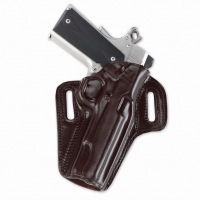 Note that this Galco holster not only raises the pistol’s grip away from your belt, but also makes sure that no part of the holster itself will interfere with your grab. It also separates your gun from your body with one layer of holster and the thickness of your belt. This is a well designed holster, because nothing can get in the way of your hand as it dives for your pistol’s grip. Next is a similar, custom-made OWB holster by Ed Buffaloe (immediately below).
Note that this Galco holster not only raises the pistol’s grip away from your belt, but also makes sure that no part of the holster itself will interfere with your grab. It also separates your gun from your body with one layer of holster and the thickness of your belt. This is a well designed holster, because nothing can get in the way of your hand as it dives for your pistol’s grip. Next is a similar, custom-made OWB holster by Ed Buffaloe (immediately below).
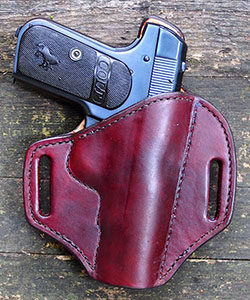
Even though Ed’s holster holds the pistol more vertically than the Galco rig does, still there is nothing to get in the way of a sure, quick snatch. This holster places a so-called sweat-guard between the gun and your body, but that extra leather is carefully cut to stay out of the way of your hand. Like the Galco, Ed’s nicely designed pouch is held just far enough from your body by both holster-leather and belt.
Now, let’s look at a fully-adjustable, hybrid, IWB rig from Alien Gear. The nicest thing about these Kydex-and-leather IWB rigs is their adjustability. You can experiment with height and angle until you discover the exact combination which best fits you, and then that configuration can be locked in place.
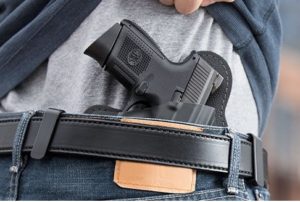 In this case, the holster has an adjustment range that allows its pouch to be lifted high enough to give the user’s hand the best possible access. Note, too, that its “sweat-guard” backing is cut so that it can’t interfere in any way. The problem with IWB holsters, however, is that they bring the gun so close to your body that it requires a bit of extra effort to push the grip just far enough away to permit you to achieve a full, firm finger-wrap.
In this case, the holster has an adjustment range that allows its pouch to be lifted high enough to give the user’s hand the best possible access. Note, too, that its “sweat-guard” backing is cut so that it can’t interfere in any way. The problem with IWB holsters, however, is that they bring the gun so close to your body that it requires a bit of extra effort to push the grip just far enough away to permit you to achieve a full, firm finger-wrap.
At first glance, it seems that the Crossbreed MiniTuck IWB hybrid (below) might permit a quick, easy grab, if you adjust its belt clips to position your pistol far enough above your belt.
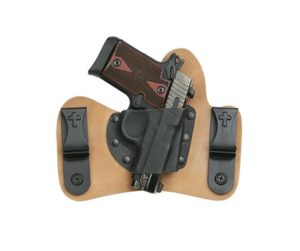 But note that there aren’t enough belt-clip screw holes to permit that. This holster will sit low, so that your belt will crowd your hand, and it will get in the way of your fingers as you go for your gun. Worse, the backing leather behind the rear belt clip rises up, channelling your grab into a very narrow area and a restricted range of motion. That’ll slow you down, and might even make you fumble.
But note that there aren’t enough belt-clip screw holes to permit that. This holster will sit low, so that your belt will crowd your hand, and it will get in the way of your fingers as you go for your gun. Worse, the backing leather behind the rear belt clip rises up, channelling your grab into a very narrow area and a restricted range of motion. That’ll slow you down, and might even make you fumble.
The next holster, the Crossbreed SuperTuck (below), can be adjusted to ride higher, and its leather backing is designed to eliminate the issue of the intruding belt clip. But then it introduces another, different complication.
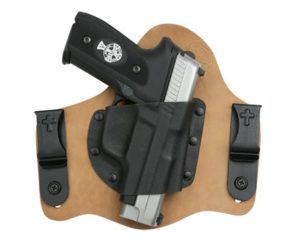 Note how the backing-leather “sweat-guard” intrudes upon the grasping area at the junction of the pistol’s trigger-guard and its handle. This will get in the way of forming a strong, full firing grip, and also it will very likely abrade your middle finger during practice. To the manufacturer’s credit, you can ask them to cut the backing deeper, so that it won’t interfere; but the design should be revised so that the problem just doesn’t exist.
Note how the backing-leather “sweat-guard” intrudes upon the grasping area at the junction of the pistol’s trigger-guard and its handle. This will get in the way of forming a strong, full firing grip, and also it will very likely abrade your middle finger during practice. To the manufacturer’s credit, you can ask them to cut the backing deeper, so that it won’t interfere; but the design should be revised so that the problem just doesn’t exist.
All fabric and elastic holsters seem to be of the one-size-fits-all persuasion, but the problem with that design philosophy is that a one-size-fits-all holster fits no pistol correctly. Let’s begin by examining Uncle Mike’s Nylon-fabric OWB Sidekick rig (below), supposedly made to fit all “medium-size” semi-auto pistols with three- or four-inch barrels.
 Starting at the top, note that this holster needs a security strap. That’s because it’s intended to fit many different pistols, so it ends up being a little loose and can’t retain your gun without help. But undoing that security strap will slow you down, and could even cause a fumble. The pistol in the picture probably has a four-inch barrel, so it rides high in the pouch, but the holster’s top edge still interferes with an important area of finger-to-grip contact. You will have to stop in mid-draw to adjust your grasp a little. And if your gun has a shorter barrel, it will bury itself deeper, making this holster an even more serious impediment to quick self-defense.
Starting at the top, note that this holster needs a security strap. That’s because it’s intended to fit many different pistols, so it ends up being a little loose and can’t retain your gun without help. But undoing that security strap will slow you down, and could even cause a fumble. The pistol in the picture probably has a four-inch barrel, so it rides high in the pouch, but the holster’s top edge still interferes with an important area of finger-to-grip contact. You will have to stop in mid-draw to adjust your grasp a little. And if your gun has a shorter barrel, it will bury itself deeper, making this holster an even more serious impediment to quick self-defense.
Elastic-fabric holsters are even worse. The two pictured here are typical of the breed, and both of them make a quick, sure draw stroke almost impossible in several different ways.
 This bellyband rig from the Sportsman’s Guide is, of course, meant to be worn under your shirt, not on top of it as the illustration suggests. It’s a “deep hideout” outfit, and, as such, it requires you to accept that you need to get half undressed just to get a hand on your pistol. But look at the way that the bellyband’s elastic pouch swallows even a full-size M1911. Once your shirt is out of the way, you still can’t get a good, firm grip on your gun without first lifting it up and then adjusting your grasp. Slow going. Fumble city!
This bellyband rig from the Sportsman’s Guide is, of course, meant to be worn under your shirt, not on top of it as the illustration suggests. It’s a “deep hideout” outfit, and, as such, it requires you to accept that you need to get half undressed just to get a hand on your pistol. But look at the way that the bellyband’s elastic pouch swallows even a full-size M1911. Once your shirt is out of the way, you still can’t get a good, firm grip on your gun without first lifting it up and then adjusting your grasp. Slow going. Fumble city!
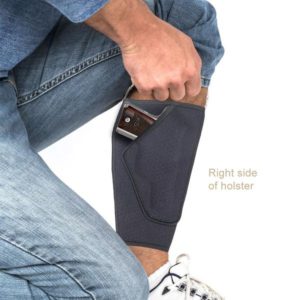
The BugBite leg holster also buries your gun, and prevents you from forming a good, solid, full firing grip. It, too, requires a lift-up-and-adjust maneuver with the pistol, once your pant-leg is out of the way. But notice that the BugBite’s pouch is way up there, high on your calf. Look at how far you have to lift your pant-leg in order to get to it. Most leg holsters hold your pistol at ankle level, needing a much shorter, faster pants lift, and the best of them are made to fit specific guns and to fully expose their handles for better quick-snatch access.
You really can’t modify an elastic holster to fit your gun properly, or even merely better. If you sew the pouch into a smaller and more-closely-fitted shape, it’s still elastic, so it will still stretch, and it will still swallow your pistol’s grip more than you’ll want it to. There was, however, at least one maker who attached a molded Kydex shell to an elastic bellyband, and, if it’s still available and if you need really deep-cover, this rig might be worth looking for.
You could stuff patches or scrap cloth down into a Nylon-fabric holster to make it lift your gun higher, or even stitch it to fit your pistol more closely, but because the holster-lining fabric is almost always slick and slippery, it will never be as secure as molded leather or Kydex. A safety strap still will be necessary.
One or two manufacturers make pouches of heat-and-pressure-molded Nylon fabric that are just as secure as those made of Kydex, and they are probably worth a look. But in every case, always be aware of possible interference with your gun-grasping fingers.
So now you know more about the most important aspect of a concealed-carry holster, and how to look for it. Use a critical eye, as you explore the rigs that you find in the marketplace. Remember that a quick, sure, life-saving pistol presentation has to be preceded by the quick, sure formation of a full firing grip. Make sure that your holster lets you do that as simply and as easily as possible.
Resources/References
Galco: http://www.galcogunleather.com/
Ed Buffaloe: http://www.unblinkingeye.com/Guns/EBCH/ebch.html
Alien Gear: http://aliengearholsters.com/
Crossbreed: http://www.crossbreedholsters.com/
Uncle Mike’s: http://www.unclemikes.com/holsters/
Sportsman’s Guide: http://www.sportsmansguide.com/
BugBite: https://www.bugbiteholsters.com/
![]()


5 Responses to The One Thing That You Really Need to Know… ...when you choose a concealed-carry holster